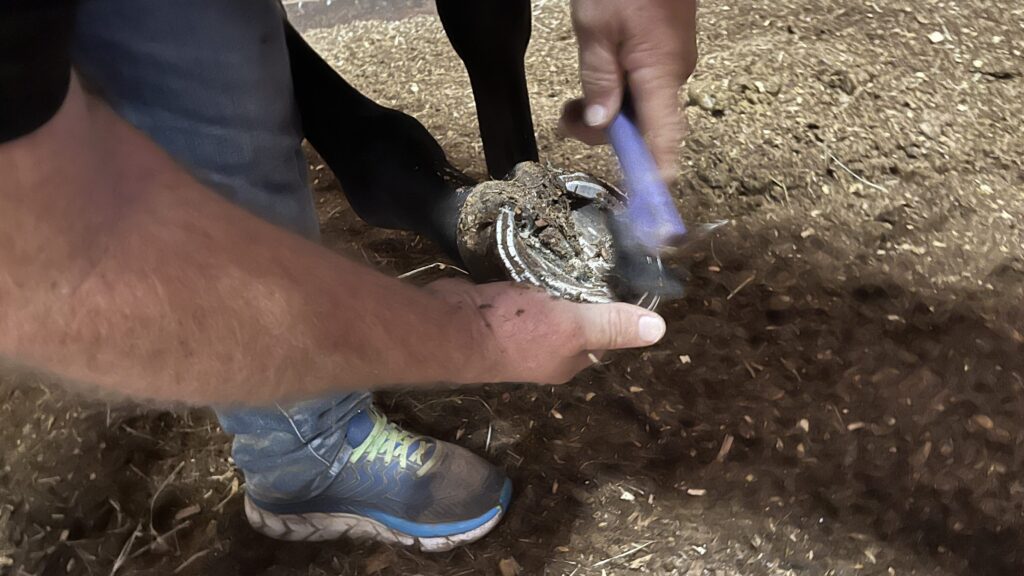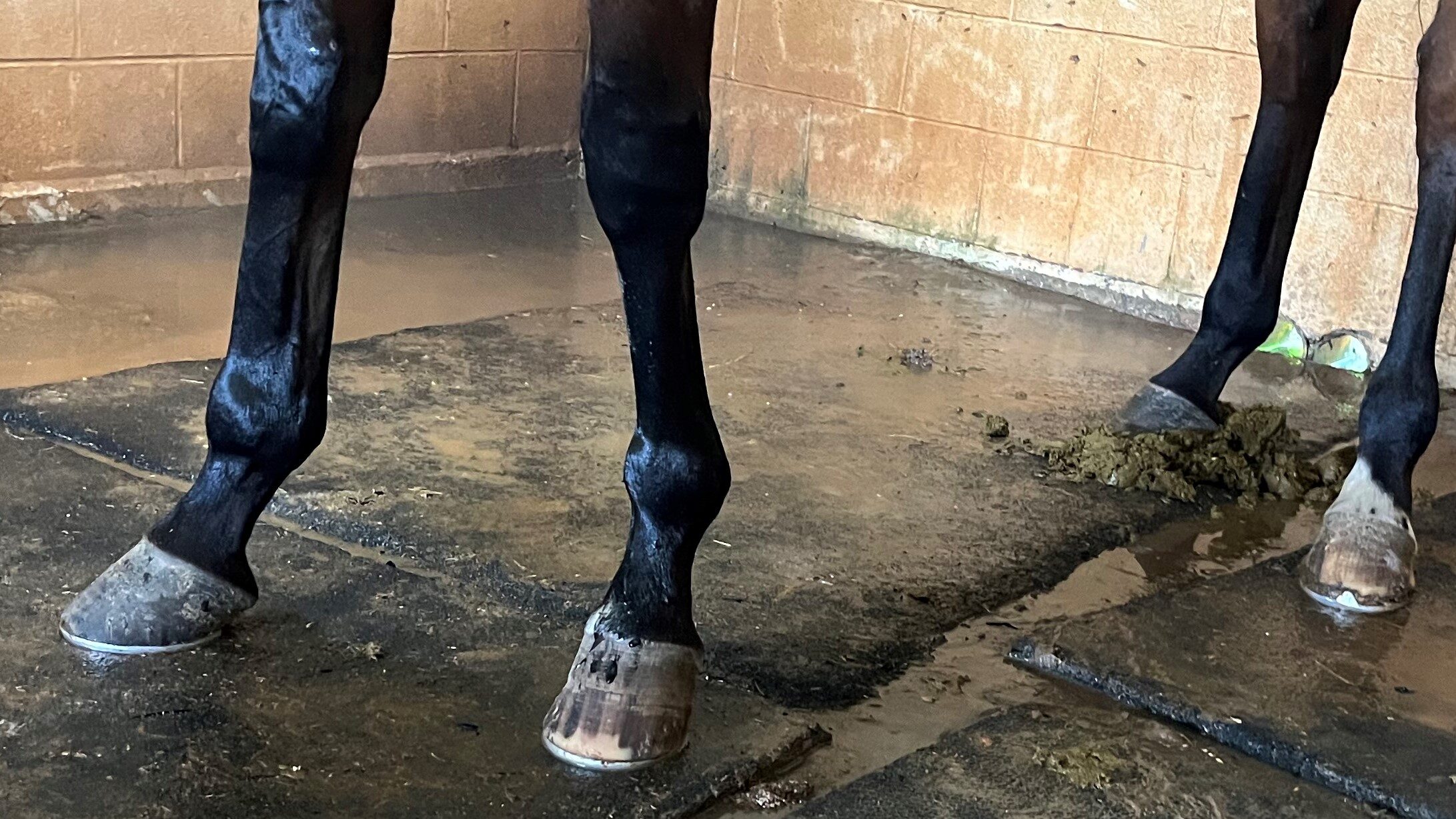Last updated: September 2, 2024
Any links on this page that lead to products on Amazon are affiliate links and I earn a commission if you make a purchase. Thanks in advance – I really appreciate it!
Do Horseshoes Hurt? It’s a common question among horse enthusiasts and those new to the equine world. The simple answer is no; when done correctly by a skilled farrier, horseshoeing should not hurt horses. Let’s delve deeper into the world of horseshoes, hoof anatomy, and the shoeing process to understand why.

When Horseshoes Hurt: Potential Risks and Discomfort
- Improper nailing:
- A nail driven too close to the sensitive inner structures can cause pain and lameness.
- Example: A young filly I claimed underperformed due to a nail driven into the sensitive part of her hoof. Proper reshoeing by a qualified farrier resolved the issue and restored her performance.
- Poorly fitted shoes:
- Shoes that are too tight or too loose can cause discomfort and hoof problems, such as abscesses, thrush, or laminitis.
- Example: A horse with poorly fitted shoes might exhibit lameness, heat in the hoof, or reluctance to move.
- Incorrect hoof trimming:
- Improper trimming disrupts the hoof’s balance and mechanics, leading to various issues:
- Toes left too long can cause tripping and stumbling, stressing tendons and ligaments.
- Heels trimmed too short can strain tendons, leading to pain and potential lameness.
- Example: We had a horse the farrier left the toe too long, causing them to trip when running. We also had a horse whose heels were trimmed too short, leading to tendon strain and an odd foot positioning.
- Improper trimming disrupts the hoof’s balance and mechanics, leading to various issues:
- Infections:
- If left untreated, bacteria can enter through nail holes, causing infections that lead to lameness, swelling, and even systemic illness.
- Example: An untreated hoof infection can spread to the hoof’s deeper structures and even the leg, requiring extensive veterinary care.
Choosing a qualified and experienced farrier is crucial to minimize these risks. A good farrier will have the knowledge and skills to:
- Assess the individual needs of each horse
- Trim the hooves correctly
- Select the appropriate type and size of the shoe.
- Fit the shoes properly
- Drive the nails safely
- Recognize and address any potential problems

Do Horseshoes Hurt? Recognizing Signs of Discomfort
If a horse is experiencing discomfort due to its shoes, it may show signs such as:
- Lameness or reluctance to move
- Heat or swelling in the hoof
- Sensitivity to touch around the hoof
- Changes in gait or posture
If you notice any of these signs, consult your farrier immediately.
- Traditional Steel Shoes: Often used for working or performance horses, providing durability and support.
- Aluminum Shoes: Lighter in weight, these are typically used for racing horses or those needing less support.
- Therapeutic Shoes: Custom-designed for horses with specific health issues or deformities, helping to correct or alleviate problems.
- Barefoot Trimming: Some horses may not need shoes at all. Proper trimming and care can allow them to be comfortable and healthy without shoes.

Understanding the Horse’s Hoof
A horse’s hoof is a marvel of nature, designed to withstand the rigors of running, jumping, and carrying weight. It’s a complex structure comprises several layers, including the insensitive outer wall, the sensitive inner layers, and the digital cushion, which acts as a shock absorber. The hoof wall is similar to a human fingernail, constantly growing and needing to be trimmed. American Farriers Association
The Shoeing Process
Shoeing a horse is a meticulous process that requires expertise and precision. A farrier, a specialist in equine hoof care, carefully trims the hoof, shapes the shoe to fit perfectly, and attaches it using nails. These nails are driven into the insensitive outer wall of the hoof, avoiding the sensitive inner structures. The Laminitis Site
The Crucial Role of a Skilled Farrier
A recent case highlighted the critical role of a skilled farrier. A young, well-bred filly was underperforming despite her pedigree. Upon closer examination, it was discovered that a nail from her shoe had been driven into the sensitive part of her hoof, causing significant pain and hindering her performance. After the shoes were removed, her hooves were trimmed and allowed to heal. Once properly reshod by a qualified farrier, the filly showed marked improvement and began performing to her full potential.

Why Horses Need Shoes
Horseshoes serve various purposes, primarily offering hooves protection, traction, and support. They safeguard the hooves from excessive wear and tear, especially in horses working on hard or rocky terrain. Additionally, horseshoes provide enhanced grip on slippery surfaces, reducing the risk of falls.
They can also help correct hoof imbalances or support injured hooves, promoting overall soundness. Specialized horseshoes are sometimes used to improve a horse’s performance in specific disciplines or address particular hoof conditions. These can range from traditional steel shoes to lightweight aluminum options and even therapeutic shoes designed for horses with specific needs.

Alternatives to Traditional Horseshoeing
In some cases, horses may benefit from alternative hoof protection options, such as:
- Hoof boots: These removable boots provide protection and support without needing nails.
- Glue-on shoes: These shoes are bonded to the hoof using adhesive, eliminating the need for nails.
- Barefoot trimming: Some horses can go barefoot with proper trimming and management. University of Minnesota, College of Veterinary Medicine

Frequently Asked Questions about Horseshoes
How often should my horse’s shoes be replaced?
Generally, every 4-6 weeks. However, the optimal timeframe depends on factors like the horse’s activity level, terrain, hoof growth rate, and shoe type. Regular farrier assessments are crucial.
How much do horseshoes cost?
The National average price of trimming plus shoeing four hooves is about $120. Trimming only can cost between $30 and $50.
Is it illegal to shoe your own horse?
Horseshoeing is not an easy process; it needs skills. A farrier undergoes four years of training to achieve this qualification. Hence, shoeing a horse should only be done by vets or farriers.
Can horseshoes be left on all year round?
It’s possible, but not always ideal. Horses’ hooves need regular trimming even with shoes. Some horses benefit from going barefoot seasonally or during periods of reduced activity. Consult your farrier for the best approach.
Is it okay for my horse to go barefoot?
Yes, many horses thrive barefoot with proper hoof care and management, especially if they have healthy hooves and low-impact activity. Consult your farrier or veterinarian to determine the best approach for your horse.
What are the signs that my horse needs new shoes?
Signs include:
-Loose or missing shoes
-Overgrown hooves extending beyond the shoe
-Worn or uneven shoes
-Lameness or changes in gait
-Sensitivity or discomfort in the hooves
Why Don’t Wild Horses Need Shoes?
Wild horses don’t need shoes because their lifestyle and environment promote healthy hoof wear and growth. They travel long distances daily over varied terrain, which naturally wears down their hooves. Their balanced diet of natural forage also contributes to strong hoof growth. Additionally, they aren’t subjected to the demands of human-directed work or performance, which can put extra strain on hooves.
Below is a YouTube video showing the benefits of hoof care.
Conclusion: Do Horseshoes Hurt Horses? The Pain Question Answered.
When performed correctly by a skilled farrier, horseshoeing is a safe and beneficial practice for many horses. It provides protection, support, and traction, allowing them to perform their best and stay comfortable. However, as we’ve seen, improper horseshoeing can lead to discomfort and even serious health issues.
If you have any concerns about your horse’s hooves or shoeing, don’t hesitate to consult with a qualified farrier. Remember, your horse’s well-being depends on proper hoof care.
We’d love to hear from you! Have you ever experienced issues with your horse’s shoes? Share your stories and insights in the comments below. Let’s create a community where we can learn from each other and ensure the best possible care for our equine companions.

About the Author: Miles Henry
Lifelong Horseman | Racehorse Owner | Published Author
Miles Henry brings over 25 years of hands-on experience training and owning Thoroughbred racehorses. Raised with Quarter Horses and Appaloosas, he’s spent a lifetime learning from horses—on the track, in the barn, and in the field. Today, he runs a small but successful racing stable in Louisiana and shares real-world insights on HorseRacingSense.com, helping horse owners, fans, and bettors navigate the sport with confidence.
📚 Books: View Miles’s books on Amazon »
🎧 Podcast Guest: Animal Tales Ep. 32 |
YouTube Interview
📩 Newsletter: Sign up for racing tips and horse care advice »
🔗 Follow Miles:
Twitter |
Facebook |
YouTube


